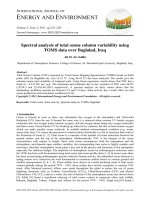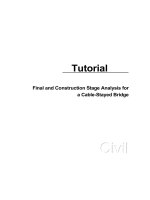Thermal-hydraulics analysis for VVR-KN fuel lead test using PLTEMP code
Bạn đang xem bản rút gọn của tài liệu. Xem và tải ngay bản đầy đủ của tài liệu tại đây (364.95 KB, 7 trang )
Nuclear Science and Technology, Vol.8, No. 1 (2018), pp. 10-16
Thermal-hydraulics analysis for VVR-KN fuel lead test
using PLTEMP code
Ho Nguyen Thanh Vinh, Le Vinh Vinh, Nguyen Nhi Dien, Nguyen Kien Cuong,
Huynh Ton Nghiem, Tran Quoc Duong and Nguyen Tien Vu
Nuclear Research Institute, 01 Nguyen Tu Luc Street, Dalat, Vietnam
E-mail:
(Received 15 April 2018, accepted 18 September 2018)
Abstract: VVR-KN is one of the low-enriched fuel types to be considered for a new research reactor
(RR) of a Centre for Nuclear Energy Science and Technology (CNEST) of Vietnam. This fuel type
was qualified by a lead test carried out with three fuel assemblies (FAs) in 6-MWt WWR-K research
reactor at the Institute of Nuclear Physics, Kazakhstan. VVR-KN fuel was then used for conversion of
the WWR-K reactor core from highly-enriched to low-enriched uranium fuel and the reactor was
successfully commissioned in September 2016. PLTEMP is a thermal-hydraulic code with plate and
coaxial tube models that seems to be suitable for VVR-KN fuel type. Before using PLTEMP code for
thermal-hydraulics analysis of the new RR, a calculation for code validation was performed based on
the data of the VVR-KN fuel lead test. First, MCNP5 code was used to calculate the power
distribution of WWR-K reactor core with lead test fuel assemblies (LTAs) at the core center. Then,
thermal-hydraulics parameters of the LTAs were obtained by using PLTEMP code together with
calculated data of the power distribution and the lead test conditions. A comparison between the
analytic results and the lead test data was made to confirm the suitability of PLTEMP code for
thermal-hydraulics analysis of VVR-KN fuel under forced convection and downward flow conditions.
Keywords:VVR-KN fuel type, MCNP5, PLTEMP, WWR-K reactor, VVR-KN fuel lead test.
I. INTRODUCTION
The CNEST project with a 10-MWt
upgradable to 15-MWt research reactor (RR)
has been in the pre-feasibility study phase.
Meanwhile, the national research project for
calculation of neutronic characteristics,
thermal-hydraulics and safety analysis of the
proposed RR loading with low enriched
Russian fuel types has been deployed.
One of selected fuel types intended for
this RR is VVR-KN, which is composed of
coaxial tubes. Additionally, PLTEMP code [1]
with plate and tube models has been used at the
Argonne National Laboratory for RRs using
Russian coaxial tube fuel type. This code
seems to be suitable for thermal-hydraulics
calculation of the new RR at steady-state
condition.
The PLTEMP code validation with the
coaxial fuel type and the natural convection
mode was achieved by comparing with the
experimental data in the Dalat research reactor
[5]. On the other hand, in forced convection
mode, the PLTEMP code was validated based
on the data of the VVR-KN fuel lead test,
which was performed in the 6-MWt WWR-K
reactor of Kazakhstan [4]. Successful
validation of the PLTEMP code was carried
out in both forced and natural convection
modes that confirms the suitability for thermalhydraulics analysis of the new RR not only in
normal operation but also in cases the decay
heat to be removed by natural convection of
reactor pool water.
This work includes neutronic and
thermal-hydraulics calculations. A spatial
©2018 Vietnam Atomic Energy Society and Vietnam Atomic Energy Institute
HO NGUYEN THANH VINH et al.
thermal power distribution of WWR-K reactor
core with experimental VVR-KN FAs is
obtained by using MCNP5 code [2].
Thereafter, using PLTEMP code together with
the results from the previous neutron
calculations and the initial conditions of the
fuel lead test to obtain thermal-hydraulics
parameters. Eventually, comparison of the
calculated results with the experimental data
confirms the suitability of the PLTEMP code
for VVR-KN fuel under the experimental
conditions.
II. METHOD AND CALCULATION RESULTS
A. VVR-KN fuel lead test
VVR-KN fuel assembly (FA) (see Fig.
1) is a low-enriched fuel type that was used for
the conversion of the WWR-K reactor core
from highly-enriched uranium fuel of 36%
(HEU) to low-enriched fuel of 19.75%of 235U
(LEU) [3]. Also, this fuel is being considered
for the new RR of the CNEST in Vietnam.
Table I. reveals main characteristics of the
VVR-KN FAs [3].
Table I. Characteristics of VVR-KN FAs.
Fuel composition
UO2 + Al
Number of fuel elements per FA (standard FA/ FA with control rod inside) 8 tubes / 5 tubes
Fuel cladding material
Uranium enrichment, %
Content of 235U per FA, g
Al (SAV-1)
19.75
245 / 196
Content of 235U per a core volume unit, g/l
Surface of heat removal per a core volume unit, cm2/cm3
Fuel element thickness, mm
Thickness of gaps between fuel elements, mm
Total weight of FA, kg
Fuel meat thickness, mm
Fuel meat length, mm
Fuel meat uranium density, g/cm3
Volume fraction of water in FA
Infinite-medium neutron multiplication factor, k∞
104.4 / 83.5
5.46 / 4.33
1.6
2
4.66 / 4.21
0.7
600
3.0
0.54
1.648
There are two types of VVR-KN FAs,
including the standard one with 8 fuel elements
(FEs) and the other with 5 fuel elements for
control rod placement inside FA-2 (Fig. 1).
For the fuel lead test, the LEU VVR-KN
FA’s width across flat is 66.3 mm, which
makes it possible to be installed into the
existing support plate using a triangular lattice
with a spacing of 68.3 mm of the HEU VVR-C
FA of WWR-K reactor. An increase in the FA
robustness in case of beyond design basis
accidents was achieved through the
longitudinal spacer ribs introduced on the FE
Fig. 1. Two types of VVR-KN FAs.
11
THERMAL-HYDRAULICS ANALYSIS FOR VVR-KN FUEL LEAD TEST …
outside which ensure the guaranteed clearance
between the FEs.
reactor can reach at the permitted thermal
power of up to 6 MWt. Its core consisted of 38
HEU VVR-C FAs, including 32 FAs with 5
FEs (FA-1) and 6 FAs with 3 FEs (FA-2)
shown in Fig. 2. To ensure the required
reactivity margin during the test, hexagonal
beryllium blocks were installed into the core’s
peripheral cells.
A program was developed for the lead
test fuel of the VVR-KN FAs in the WWR-K
reactor. An experimental device of three
experimental VVR-KN FAs (EFAs) with
beryllium blocks around was placed in the
reactor core center (Fig. 2). The WWR-K
Fig. 2. WWR-K reactor core mapwith HEU VVR-C FAs and three LEU EFAs [4].
The purpose of the tests was to achieve a
burn-up of 60% in which defined the life of the
reactor FEs. For this purpose, three 8-element
EFAs were manufactured with the following
235
U mass: 245.3 g in LTA-1, 244.7 g in LTA2, and 245.0 g in LTA-3.
of 816 days, including 480 days at the reactor
power rate of 6 MWt. The average 235U burnup of 59.7% (LTA-2) and 60.3% (LTA-3) was
achieved.
The safe operating mode for VVR-KN
EFAs (no fuel cladding surface boiling) was
maintained during the experiment.
The parameters which were monitored
during the fuel lead test include the coolant
temperatures at the core inlet and outlet, the
coolant temperature at the outlet of the
experimental device with three VVR-KN EFAs
inside, the coolant flow rate through the reactor
core, the coolant level in the reactor pool, the
coolant pressure at the EFAs outlet, the coolant
and air activity beneath the reactor head.
Table II presents thermal-hydraulics
analysis results from the fuel lead test [4].
Table II. Thermal-hydraulics analysis results for
VVR-KN EFAs.
The VVR-KN fuel lead test was
successfully performed with the total duration
12
Reactor power, MWt
5.65
Reactor pool water level, m
5.3
Total power of three EFAs, kWt
989
Power of most heat-rated EFA, kWt
333
HO NGUYEN THANH VINH et al.
Core inlet coolant temperature, 0C
32
Maximum fuel cladding temperature, 0C
88
2
Maximum heat flux, kW/m
Accordingly, thermal power of the three EFAs
were of 325 kWt, 322 kWt, and 337 kWt
respectively (Fig. 3).
508
2
Hot-spot heat flux, kW/m
374
0
Hot-spot saturation temperature, C
107.4
0
Surface boiling onset temperature, C
114.7
Surface boiling onset temperature
margin
1.43
Flux instability safety margin
2.1
B. Calculation of thermal power distribution
MCNP5 code was used to calculate
thermal power of three EFAs placed in the
WWR-K RR, as well as their spatial thermal
power distribution in the reactor core.
Fig. 3. Thermal power of the three EFAs.
The axial thermal power distribution was
obtained as well and shown in Fig. 4. As it is
evident from the Fig. 4 that the power peaking
factor of EFAs were of 1.287, 1.286, and 1.290
each one.
MCNP5 is a general-purpose Monte
Carlo N-Particle code that can be used for
neutron, photon, electron, or coupled
neutron/photon/ electron transport, including
the capability to calculate eigenvalues for
critical systems [2].
The calculation of the thermalhydraulics parameters, as well as safe margins,
required attention to thermal power at hottest
positions. So that, the hot channel factors of
each fuel element of EFAs were calculated by
MCNP5 code and presented in Table III.
Geometrical model of WWR-K RR
including three LEU VVR-KN EFAs, all
HEU VVR-C FAs, beryllium reflector and
core configuration was imported into
MCNP5 input file.
After executing the code, results of the
EFAs thermal power distribution were gained.
Factor of thermal power
1.400
1.300
1.200
1.100
1.000
0.900
0.800
0.700
0.600
45 75 105 135 165 195 225 255 285 315 345 375 405 435 465 495 525 555
Distance from the top of EFAs
Fig. 4. Axial thermal power distribution of EFAs.
13
THERMAL-HYDRAULICS ANALYSIS FOR VVR-KN FUEL LEAD TEST …
Table III. Factor of thermal power at the hottest position of EFAs.
1st FE
2nd FE
3rd FE
4th FE
5th FE
6th FE
7th FE
8th FE
1st EFA
1.455
1.417
1.404
1.415
1.445
1.478
1.534
1.613
2nd EFA
1.458
1.420
1.408
1.419
1.448
1.482
1.538
1.617
3rd EFA
1.363
1.327
1.316
1.326
1.353
1.385
1.437
1.511
The coolant flow rate through an EFA
is 13 m3/h;
Total thermal power of the EFAs is
983 kWt;
C. Thermal-hydraulics analysis
The calculation of cladding surface
temperature, coolant temperature and safety
margins of EFAs was performed by using
PLTEMP V3.8 code.
All these conditions together with
geometry of EFAs, coolant flow and previous
calculated results of the EFAs thermal power
distribution were imported into input file of
PLTEMP code. Additionally, the system error,
such as uncertainty of power and flow
measurement, heat transfer coefficient, must be
considered to obtain the desired results. The
obtained thermal-hydraulics parameters are
presented in Table IV and Fig. 5.
PLTEMP code is a thermal-hydraulics
code for plate and concentric-tube geometry
with capability of calculating natural
circulation flow. It was also used to analyze
thermal-hydraulics parameters for core
conversion of the Dalat RR from HEU to LEU
fuel [5].
The initial conditions of the VVR-KN
fuel lead test were as follows:
Eventually, the computing results were
compared with experimental ones obtained
from VVR-KN fuel lead test (Table V).
The coolant temperature at the core
inlet is 320C;
Table IV. Cladding temperature and coolant temperature of the EFAs with system error.
Distance from
the top
(mm)
45
75
105
135
165
195
225
255
285
315
345
375
405
1st EFA
Cladding
Coolant
temp.
temp.
(0C)
(0C)
56.072
60.471
64.942
68.992
73.012
76.444
79.210
81.649
83.535
84.721
85.662
85.938
85.496
33.269
34.208
35.301
36.540
37.914
39.405
40.983
42.624
44.305
45.994
47.668
49.307
50.877
2nd EFA
Cladding
Coolant
temp.
temp.
(0C)
(0C)
56.379
60.833
65.361
69.463
73.535
77.013
79.817
82.291
84.206
85.414
86.374
86.662
86.225
14
33.293
34.250
35.365
36.628
38.027
39.547
41.154
42.825
44.537
46.257
47.963
49.632
51.232
3rd EFA
Cladding
Coolant
temp.
temp.
(0C)
(0C)
55.158
59.403
63.721
67.632
71.515
74.829
77.502
79.858
81.682
82.830
83.741
84.009
83.584
33.223
34.128
35.181
36.374
37.697
39.134
40.653
42.232
43.850
45.476
47.088
48.666
50.179
HO NGUYEN THANH VINH et al.
435
465
495
525
555
585
84.554
83.253
81.232
78.900
76.608
77.175
52.353
53.718
54.949
56.030
56.960
57.812
85.282
83.975
81.941
79.591
77.282
77.861
52.735
54.124
55.379
56.480
57.428
58.296
82.675
81.417
79.466
77.213
74.999
75.547
51.600
52.914
54.100
55.141
56.037
56.858
Temperature, 0C
90
80
Cladding
temperature of
EFAs
70
60
50
Coolant
temperature of
EFAs
40
30
20
45 105 165 225 285 345 405 465 525
Distance from the top of EFAs, mm
Fig. 5. Cladding and coolant temperature of the EFAs.
Table V. Comparison of the experimental with calculated results.
Parameters
Lead Test
PLTEMP
Reactor power, MWt
5.65
5.65
Power of three EFAs, kWt
989
983
333
337
Core inlet coolant temperature, C
32
32
Maximum fuel cladding temperature, 0C
88
86.7
374
387
Hot-spot saturation temperature, 0C
107.4
107.4
0
Surface boiling onset temperature, C
114.7
115.4
Surface boiling onset temperature margin
1.43
1.5
Flux instability safety margin
2.1
2.2
Power of the most heat-rated EFA, kWt
0
2
Hot-spot heat flux, kW/m
surface boiling onset temperature margin
(ONBR) is 1.5.
III. CONCLUSION
According to the calculated results
shown in Table IV, the highest cladding
temperature of VVR-KN EFAs is 86.6620C,
the highest coolant temperature is 58.2960C,
and in Table V, the minimum flux instability
safety margin (FIR) is 2.2 and the minimum
Because the highest temperature at the
outlet of the EFAs is far from saturated
temperature (107.40C) so much, belong with
obtained FIR and ONBR, it can be concluded
that the EFAs operated safely during the test.
15
THERMAL-HYDRAULICS ANALYSIS FOR VVR-KN FUEL LEAD TEST …
[4] F. M. Arinkin, L. V. Chekushina, P. V.
Chakrov, Sh. Kh. Gizatulin, S. N. Koltochnik,
D, Nakipov, A. A. Shaimerdenov, N. Hanan,
P. Garner and J. Roglands-Ribas, “Results of
the trial of lead test assemblies in the WWR-K
reactor”. RRFM 2014, Slovenia, 2014.
As it can be also seen in Table V, that
the thermal-hydraulics parameters published
from the VVR-KN fuel lead test and those
computed by PLTEMP code are similar.
Therefore, the PLTEMP code can be used for
the thermal-hydraulics design of the new
nuclear research reactor loaded with LEU
VVR-KN FAs of the CNEST project.
[5] “Report on neutronics and steady-state thermalhydraulics analyses for DNRR full LEU core
configurations”, Reactor Center, Dalat Nuclear
Research Institute, VINATOM, Dalat, 2012.
REFERENCES
[1] Arne P. Olson, M. Kalimullah, “A users guide
to
the
PLTEMP/ANL
V3.8
Code”,
ANL/RERTR, Argonne National Laboratory,
June 2009.
[2] J. F. Briesmeister, Ed., “MCNP - A General
Monte Carlo N-Particle Transport Code,
Version 5”, LA-13709-M, April 2000.
[3] Yu. S. Cherepnin, S. A. Sokolov, S. Yu. Bulkin,
V. A. Lukichev, O. V. Kravtsova, A. I.
Radaev, “Conversion of the WWR-K research
reactor to low-enriched fuel as the basis for the
development and introduction of the VVR-KN
fuel assemblies in existing and advanced pooltype research reactors”, NIKIET, Moscow,
Russia, 2014.
16









